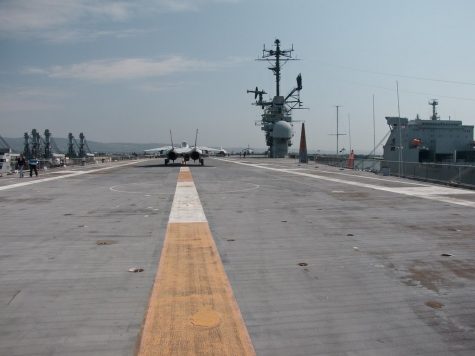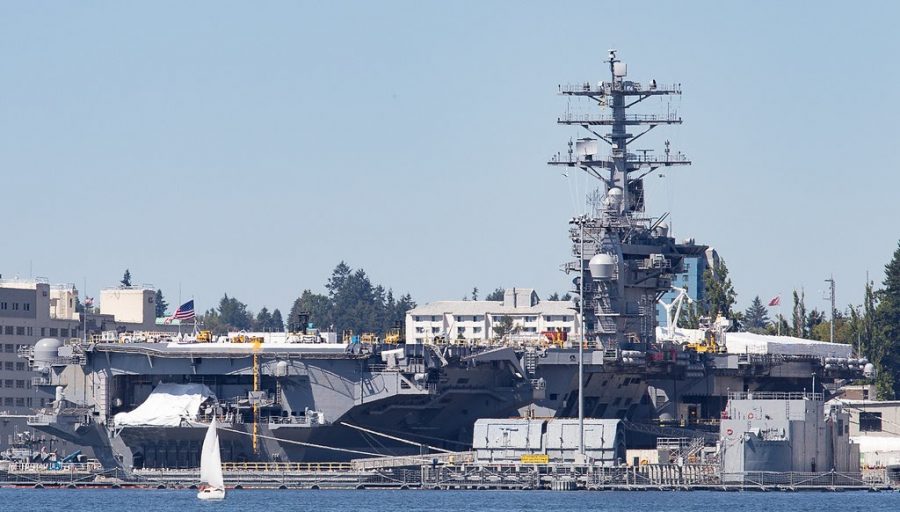What is Life Like on an Aircraft Carrier?
May 13, 2020
What weighs 100,000 tons, is 333 meters long, and floats on the water? Not a whale, not a glacier, but a Nimitz class aircraft carrier. The reigning champion in military ship size, the deck on a Nimitz is so large that more than three full-sized football fields could fit on it. Football, however, is not what a carrier is used for, and $8.5 billion would seem excessive for a sports facility.
But why does a carrier cost so much? As a floating airport, a Nimitz class aircraft carrier carries anywhere from 85 to 90 aircraft at a time. With the assistance of a catapult-like system on deck, aircraft can take off of the carrier in a matter of seconds. During World War II, this machine allowed countries to launch aerial attacks literally out of the blue, giving them the crucial element of surprise.
Powered by two nuclear reactors, the Nimitz is fitted with all the latest technology. From propulsion to reactor cooling to electricity production, the reactors do it all. With the help of these reactors, a carrier can stay at sea for prolonged periods of 6-9 months without ever returning to port.
With a crew capacity of 6500, the Nimitz can be considered a small city. From aircrew, landing signal officers, to catapult crew, the efficiency and fluidity with which the crew works is mind-boggling. Every member on board is a crucial piece to the puzzle of smooth operation. A carrier is said to be not only a great expression of human creativity, but of human cooperation and coordination.
My own father spent five years in the Navy, working on the nuclear reactor inside the USS Abraham Lincoln, one of the Nimitz class carriers. Given this unique background, I thought it would be interesting to ask him about his experience on the ship, so the following information comes from him.
The start of the day is never the same on an aircraft carrier. Everyone has watch duties, which the timing of can change depending on the shift assigned. Standard watch most often consists of watching over and guarding equipment. For someone on watch from say 2 a.m. to 6 a.m., that’s when the day starts. Adequate sleep can be very hard to come by as a sailor.
For officers, there is a morning briefing at 6 a.m. Any important information about the day will be discussed. At 7 o’clock it’s breakfast time. The dining halls, a.k.a. “mess decks,” are larger than on any other ship, seating roughly 100 people. Being cooked by the “mess cranks” for 6500 people, gourmet food is not part of the Navy budget. Sadly, variety is also sometimes lacking, especially at lunch. Monday is grilled cheese, Tuesday is grilled cheese with ham, Wednesday is grilled cheese with sausage, and so on. After the morning meal, comes the 8 a.m. meeting, where the officers will give a briefing to all of the enlisted men.
At this point, the work officially begins for the day. Variety is plentiful when it comes to jobs on the carrier. On the flight deck alone, there are 30 or so different jobs, which are distinguished by the color of uniform. The air boss, an officer stationed up in the tower, is responsible for coordinating all things aircraft related. Appropriate wind speed is crucial for the successful takeoff of an airplane. The airboss will calculate the wind speed, ordering the adjustment of the position and speed of the carrier to meet the required conditions.
A city needs a hospital, doesn’t it? A carrier is equipped with its very own, with 20 doctors on staff, half of them being dentists. This may come as a surprise, as dental health may seem like an afterthought when at sea. However, it is the opposite: toothaches lead to headaches. With a headache, eating, sleeping, and concentration on work are all virtually impossible. Without healthy sailors, a carrier will fail to function.
One unique thing about life on a carrier is that activity happens around the clock. The US Navy is different to others in that airplanes will sometimes fly 12 hours straight. The constant activity can also cause some extra dangers. Consequently, the flight deck can be one of the most precarious work environments in the world. When working on the deck, complete concentration and awareness of surroundings is required. Getting in the way of others can prove fatal, and one of the most common fatalities is being sucked into the aircraft engine.
Of course, the US Navy does a good job of setting a standard of awareness and competence, making serious accidents uncommon. Being a high-risk environment, emergency drills are a common part of life on a carrier.

From nuclear, fire, to chemical drills, the carrier has them all. For each type of drill, crew are assigned to “battle stations,” put on different types of protective clothing, and perform emergency tasks. Sailors are always prepared in the case of disaster.
At around 5 p.m., when the bulk of the day’s work is done, it is time for dinner. This meal is not actually not the last of the day: At midnight, there is something called “mid-rats” or midnight rations. This is a small meal for those working late-night or early-morning shifts. For all meals other than breakfast, the soft serve ice cream machine is center stage. Judging by the amount of concern placed on the health of this particular contraption, one might judge that it is as important to the operation of the ship as the reactors.
With all this work and stress, when is the time for the officers to relax? Recess is not a part of the daily schedule for a naval officer. “Free time” is often taken up by required tasks, but once finished there is some freedom to be had. On a carrier, there are a surprising amount of things to do, and due to the size and space many personal possessions are allowed. Bicycles, fishing rods, and exotic carpets are just some of the items a sailor can store on the ship. Television time is more important to some than it is to others. Some will go as far as trading or buying other people’s watch shifts so that they are able to be free when a certain show is on.
For those sailors who prioritize physical fitness, there are multiple gyms on ship, equipped with everything needed to work up a sweat. Surprisingly, running is even allowed in places like the hangar or flight deck. Every once in a while, when the ship is near the equator, activity is halted for what is known as “steel beach picnic.” On this day, sailors can take a dip in tropical waters, catch some sun, eat some barbecue, and enjoy all sorts of other leisure activities.
Life on an aircraft carrier shares many similarities to the current state of quarantine most people are in. Sailors can watch shows they like, exercise, and get a little fresh air, but they can’t see all the people they’d like to and their actions are necessarily limited. Like these sailors, we are all currently committed to a bigger cause. We are together in the fight against coronavirus, and we can’t win without all hands on deck. So let’s take a step back, evaluate our situation, and be grateful for what we do have. Like life at sea, this is all temporary, and for the greater good.





















Max • Aug 17, 2020 at 8:26 PM
Great article!